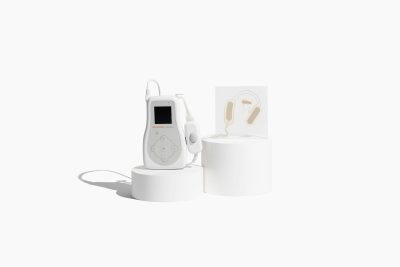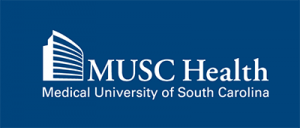Clinical trial to test wearable device as treatment for chronic pain, opioid withdrawal
January 19, 2023Collaborative study awarded to the Medical University of South Carolina, University of Texas Medical Branch and Spark Biomedical
A multi-year clinical trial at the Medical University of South Carolina (MUSC) and University of Texas Medical Branch (UTMB) will examine the use of a wearable device thought to stimulate nerves near the ear to change signals in the brain as a treatment for chronic pain and opioid tapering.
The trial, known as tANdem, is being funded by an $8.8 million grant from the National Institutes of Health National Institute of Neurological Disorders and Stroke, and is designed to provide an understanding of the mechanistic, neurophysiological and antinociceptive effects of transcutaneous auricular neurostimulation (tAN), which has been shown to reduce pain and the symptoms of withdrawal.
 “The opioid crisis has spawned untold deaths and chronic disabilities with a major impact on global health care,” said Dr. Kathryn Cunningham, a translational pharmacologist and director of UTMB’s Center for Addiction Research highlighted. “Our collaborative project will determine the efficacy of tAN to ease tapering of real-world patients from opioid management of chronic pain with reduced withdrawal symptoms. Importantly, neurostimulation therapy will provide a much needed and innovative treatment option over existing opioid analgesics with high risk for misuse, opioid use disorder, and overdose.”
“The opioid crisis has spawned untold deaths and chronic disabilities with a major impact on global health care,” said Dr. Kathryn Cunningham, a translational pharmacologist and director of UTMB’s Center for Addiction Research highlighted. “Our collaborative project will determine the efficacy of tAN to ease tapering of real-world patients from opioid management of chronic pain with reduced withdrawal symptoms. Importantly, neurostimulation therapy will provide a much needed and innovative treatment option over existing opioid analgesics with high risk for misuse, opioid use disorder, and overdose.”
Amid the opioid epidemic, a treatment chasm has emerged. Countless patients are being encouraged to avoid or discontinue opioid use for acute pain relief and chronic pain conditions for which opioids are a daily necessity. Providers must balance the need to reduce opioid harm while simultaneously managing a patient’s pain. Within this gap, non-opioid, non-pharmacological solutions could provide the much-needed answer.
Neurostimulation devices targeting the cranial nerves have long been used for pain control. In particular, the stimulation of the vagus nerve (VNS) and trigeminal nerve (TNS) has demonstrated success as an analgesic in acute pain, post-surgical pain, and chronic pain disorders.
Wearable tAN therapy, which combines VNS and TNS, has the potential to improve pain therapy significantly by providing a safe, effective, and convenient means to facilitate both acute and long-term pain relief without the risks associated with opioids or other pain-relieving medications or the need for implantable devices used by many current neuromodulation treatments.
Spark Biomedical developed the Sparrow Therapy System—the first FDA-cleared wearable, non-invasive tAN device for the treatment of opioid withdrawal. Use of the Sparrow device for pain management will be investigated in this trial, which will be a pioneering multi-site collaborative effort bringing together experts in pain, addiction, neurostimulation and neuroimaging.
The trial is led by principal investigators Denise Wilkes, M.D., Ph.D., UTMB Professor, Department of Anesthesiology and Pain Medicine; David Houghton, Ph.D., UTMB Assistant Professor, Department of Psychiatry and Behavioral Sciences; Bashar Badran, Ph.D., MUSC Assistant Professor, Department of Psychiatry and Behavioral Sciences; and Navid Khodaparast, Ph.D., Spark Biomedical Co-founder and Chief Science Officer. Co-investigators include Kathryn Cunningham, Ph.D., UTMB Professor, Department of Pharmacology; Jeffrey Borkhardt, MUSC Professor, Department of Psychiatry and Behavioral Sciences; and Melanie McWade, Ph.D., Spark Director of Clinical Operations.
“Over the last 15 years of studying the development of opioid analgesia tolerance, I have found a higher degree of tolerance with high-dose opioids in animal models and have witnessed similar opioid tolerance and treatment dissatisfaction with high-dose opioids in my patients,” said Wilkes, pain clinician and researcher at UTMB. “My team and I have developed and published strategies to help to wean patients off high-dose opioids and found huge changes in patients’ lives with dose reduction. We are interested in the management and treatment for a condition of trigeminal nerve derangement and trigeminal neuralgia and how this affects both emotional stability and chronic pain.
“I am excited to learn how this technology of trigeminal and vagus nerve stimulation can help chronic pain patients to control their opioid use and help them to navigate these times of the opioid crisis,” Wilkes said.
Houghton, a clinical psychologist at UTMB, said the diverse team of investigators is key to this effort.
“An enormous number of pain patients are prescribed an opioid analgesic and require more effective ways to get off of these drugs while not facing terrible pain and withdrawal,” said Houghton. “Auricular vagus and trigeminal stimulation could be an excellent remedy to this clinical problem; however, we need to better understand the mechanisms through which this type of neurostimulation ameliorates pain and withdrawal. To tackle this question, we have formed a diverse team of scientists and clinicians from academia and industry to conduct a series of translational studies that will significantly advance our understanding of tAN’s underlying neurobiological effects. These projects will form a robust foundation of meaningful science that supports using tAN as a pain intervention, using tAN to help chronic pain patients to reduce their opioid use as well as maximizing patient responses to tAN.”
Badran, a neuroscientist and the director of the MUSC Neuro-X Lab, has high hopes for the study.
“Accumulating data from our lab and others suggest that auricular vagal and trigeminal stimulation modalities activate the central and peripheral nervous systems,” Badran said. “We live in a moment in history where wearable technologies have the potential to impact how we treat psychiatric and neurological disorders substantially. Opioid withdrawal and pain patients need better treatment options. Ultimately, noninvasive wearable brain stimulation may emerge as a promising nonpharmacological therapy, if we understand and optimize how it works.
“We’re excited to be using the advanced neurostimulation and neuroimaging techniques developed in our lab to begin understanding the underlying mechanism of tAN more concretely.”
Spark’s Khodaparast, noted, “We believe our FDA-cleared tAN therapy produces antinociceptive and opioid withdrawal mitigating effects. This study will use fMRI brain imaging in healthy and chronic pain participants to elucidate the mechanism of tAN further. Understanding the mechanism will enable future work to optimize dosing parameters, generate safer tapering protocols and ultimately improve pain treatment.”
The trial began in late 2022 and will run through fall 2027.
About MUSC
Founded in 1824 in Charleston, MUSC is the state’s only comprehensive academic health system, with a unique mission to preserve and optimize human life in South Carolina through education, research and patient care. Each year, MUSC educates more than 3,000 students in six colleges – Dental Medicine, Graduate Studies, Health Professions, Medicine, Nursing and Pharmacy – and trains more than 850 residents and fellows in its health system. MUSC brought in more than $297.8 million in research funds in fiscal year 2022, leading the state overall in research funding. For information on academic programs, visit musc.edu.
As the health care system of the Medical University of South Carolina, MUSC Health is dedicated to delivering the highest-quality and safest patient care while educating and training generations of outstanding health care providers and leaders to serve the people of South Carolina and beyond. Patient care is provided at 14 hospitals with approximately 2,500 beds and five additional hospital locations in development; more than 350 telehealth sites, with connectivity to patients’ homes; and nearly 750 care locations situated in all regions of South Carolina. In 2022, for the eighth consecutive year, U.S. News & World Report named MUSC Health the No. 1 hospital in South Carolina. To learn more about clinical patient services, visit muschealth.org.
MUSC and its affiliates have collective annual budgets totaling $5.1 billion. The nearly 25,000 MUSC team members include a world-class faculty, physicians, specialty providers, scientists, students, affiliates and care team members who deliver and support groundbreaking education, research and patient care.
The MUSC Neuro-X Lab is a multidisciplinary neuromodulation, engineering and innovation laboratory housed within the Department of Psychiatry and Behavioral Sciences at the Medical University of South Carolina. Founded and directed by Bashar Badran, Ph.D., Neuro-X fosters an environment of neurotechnology and innovation to begin addressing complex medical and neuropsychiatric disorders. Learn more at NeuroXLab.com.
About the University of Texas Medical Branch
Texas’ first academic health center opened its doors in 1891 and today has four campuses, five health sciences schools, five institutes for advanced study, a research enterprise that includes one of only two national laboratories dedicated to the safe study of infectious threats to human health, a Level 1 Trauma Center and a health system offering a full range of primary and specialized medical services throughout the Texas Gulf Coast region. UTMB is an institution in the University of Texas System and a member of the Texas Medical Center. UTMB is a major biomedical science campus with over 1.1 million square feet of research space and $236 million in current sponsored research funding. Several multidisciplinary research centers of excellence address aging, cancer, environmental toxicology, structural biology and tropical disease. For additional information, visit utmb.edu.
The UTMB Center for Addiction Research (CAR), an institutional center of excellence, provides the infrastructure for research and education in substance use disorders. Directed by Kathryn Cunningham, Ph.D., the CAR mission is to improve the course of chronic health disorders through understanding biological mechanisms and translating these discoveries into novel therapeutics to increase the quality of life of people within our community, state and world. Visit utmb.edu/car to learn more.
About Spark Biomedical
Spark Biomedical, Inc. is a leading U.S.-based wearable neurostimulation solutions developer devoted to the life-saving work of helping 36.3 million people worldwide overcome withdrawal, heal from addiction, and achieve the better quality of life they deserve. With opioid-related misuse and overdose deaths on the rise, the company’s mission is to eliminate opioid addiction by working to address the full opioid addiction lifecycle, including withdrawal management, opioid-sparing, relapse prevention, and PTSD/trauma abatement.
Spark Biomedical is helping patients take the first step of overcoming acute opioid withdrawal with its FDA-cleared wearable technology, the Sparrow Therapy System — Transcutaneous Auricular Neurostimulation (tAN®) for Opioid Withdrawal Relief. Sparrow™ Therapy provides an easy, safe, and effective drug-free treatment option supported by clinical evidence. Next steps are underway with the launch of two NIDA-funded clinical trials to improve adult relapse rates and help infants suffering from Neonatal Opioid Withdrawal Syndrome (NOWS). Learn more at sparkbiomedical.com.
About the grant
Research is supported by the National Institute of Neurological Disorders and Stroke of the National Institutes of Health under award number RM1NS128787. The content is solely the responsibility of the authors and does not necessarily represent the official views of the NIH.















